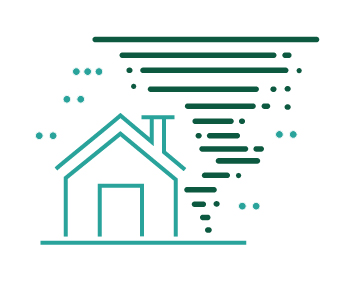
Tornado Safety and Recovery
While no structure can be 100 percent tornado-proof, it’s critical, especially in tornado-prone areas, to make sure homes and businesses can withstand as much wind as possible, and are resilient – able to return to functionality fairly quickly after the event. Below are helpful tips to make sure you are tornado ready.
Preparing for a Tornado – Creating a Safe Room
In the spring, people often begin thinking about their gardens. They also should consider whether their homes and businesses have strong roots as tornado season begins.
An average of 1,000 tornadoes a year hit the United States, with many occurring in various “Tornado Alleys,” such as the Plains states, including Texas, Oklahoma, Nebraska and Kansas.
While no structure can be 100 percent tornado-proof, it’s critical, especially in tornado-prone areas, to make sure homes and businesses can withstand as much wind as possible. You also want these structures to be resilient, meaning they are able to return to functionality fairly quickly after the event.
A properly built, high-wind-resistant safe room protects your family from the most intense tornadoes and hurricanes and can be incorporated into a planned build or renovation to create a multiuse space in your home, adding to its value. The Federal Alliance for Safe Homes (FLASH) urges homeowners to "Give an Ordinary Room an Extraordinary Purpose" by building or retrofitting interior spaces in their home to safe room standards.
Safe rooms:
- are designed to withstand winds up to 250 miles, and offer lifesaving refuge for families in the path of high-wind events like tornadoes.
- are designed to meet standards set forth by the National Storm Shelter Association, the International Code Council and FEMA, and will stand up to the most intense tornadoes and hurricanes.
- can be located anywhere on the first floor of your home, in a basement or outside. A safe room can double as a closet, bathroom, laundry or even an outdoor room like a garden shed or pool house.
Being prepared goes a long way toward keeping you and your loved ones safe during the storm.
Helpful tips from the International Code Council to make sure you are tornado ready
At the beginning of tornado season in your area
- Make sure your family has a plan to congregate in a safe place during a storm.
- Warn your children about finding a safe place away from home.
- Store flashlights and extra batteries.
- Clean storm gutters and drains.
- Prepare your home for high winds and rain.
- Repair/replace storm shutters.
- Check your property insurance policy for appropriate coverage.
Before the storm
- Bring in outdoor objects such as lawn furniture, toys, and garden tools. Anchor objects that cannot be brought inside.
- Check/replace emergency supplies and store bottled drinking water.
- Review family emergency plans.
- Keep a supply of flashlights and extra batteries handy.
- Secure your home by unplugging appliances and turning off electricity and the main water valve.
During the storm
- Stay inside in a secure place, away from windows, skylights, and glass doors. Listen to a crank- or battery-operated radio for storm progress reports. DO NOT GO OUTSIDE.
- Stay away from electrical equipment and piping that can conduct electricity from lightning.
- Keep a supply of flashlights and extra batteries handy.
- Avoid flooded roads, and watch for washed-out bridges.
After the storm
- Listen for the all-clear from a community siren, or from local radio. Make sure everyone is okay; get emergency help, as needed.
- Be careful as you assess the damage in your home, watching for live wires, broken glass, nails and other debris
- Take pictures of any damage to the house and its contents for insurance claims.
- Check the exterior. Avoid loose or dangling power lines and report them immediately to the power company, police or fire department. The same goes for gas lines.
- Let your insurance company know of any damage. Work only with accredited companies on any repairs. If you suspect a scam, report it to authorities.
Tornado Awareness and Risk Mitigation Webinar held on February 15, 2022
Webinar Presentation Documents
More Information
- Ready.gov Tornado Safety Guide
- Preparing for Tornados and High Winds by Simpson Strong-Tie
Additional Guidance from FEMA
- FEMA P-361 – Safe Rooms for Tornadoes and Hurricanes: Guidance for Community and Residential Safe Rooms
- FEMA P-320 – Taking Shelter from the Storm: Building a Safe Room for your Home or Small Business
- FMEA P-804 – Wind Retrofit Guide for Residential Buildings


